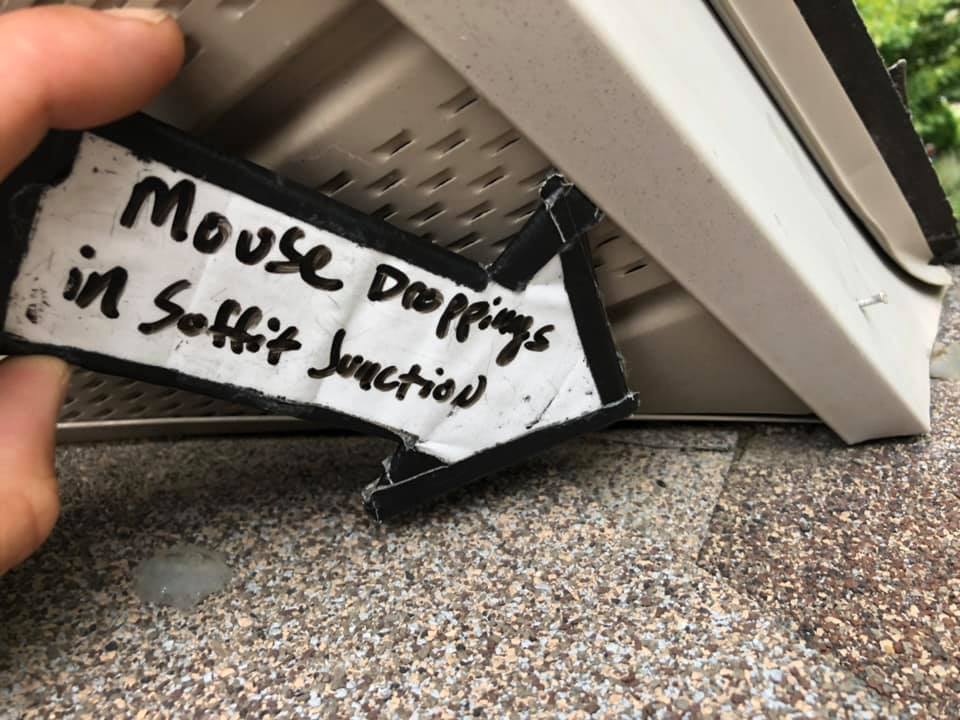Twin Cities homes and businesses are no strangers to mice. Mice have extraordinarily high metabolisms and inability to regulate their body temperatures. They require shelter and nearby food sources, and will utilize man-made shelters whenever they are available. During the winter especially, mice will look to enter homes to escape the cold.
The species of mice most prevalent in our area are the Deer Mouse and the White Footed Mouse, both are excellent climbers whose natural habitats include trees. Mice can and will climb as high as your roofline in search of an entry point into your home. Homes with brick, stucco or other naturally occurring or porous materials can be scaled easily by mice.
Mice Entering Your Home Attic
 Once they reach the roofline (or along the way) they seek drafts and air gaps, created by the changing seasons or by improper building, to find entry points. These can be located at soffit junctions, gable corners, frieze board or trim gaps, vents into soffits or attics, and numerous other builder’s gap areas.
Once they reach the roofline (or along the way) they seek drafts and air gaps, created by the changing seasons or by improper building, to find entry points. These can be located at soffit junctions, gable corners, frieze board or trim gaps, vents into soffits or attics, and numerous other builder’s gap areas.
Mice in the attic are typically discovered via scratching noises, or by someone visually inspecting the attic. It is important to utilize proper personal protective equipment anytime the attic hatch is opened. For Abra Kadabra technicians, this includes a tyvek suit, respirator, gloves and goggles.
Evidence Of Mice Presence In The Attic
Noise
Mice usually create a scratching sound that is relatively stationary. They are especially common at ground level, but are frequently found in attics when the exterior of the building is porous or there are trees overhanging the roof that mice could climb from.
Mice are nocturnal, so these noises would be heard during the evening. Noises can often seem amplified, as if a squirrel is above you or in your walls. The “knock test” is a good way to determine if what you are hearing is a mouse. Knock on the wall or ceiling near the noise. If it continues, it is not mice. If it stops for a period of time then resumes, it is likely you have mice.
Tunneled insulation
 When mice tunnel through insulation it leaves a distinct web-like appearance. In an attic you will see trails on top of the blown insulation where mice have tunneled beneath, slightly collapsing the material above it. In semi-finished attics, you will see either blown or rolled insulation in the walls full of tunnels and holes, with a swiss cheese appearance. You may also see some of that material pulled out as they gathered it for nesting materials.
When mice tunnel through insulation it leaves a distinct web-like appearance. In an attic you will see trails on top of the blown insulation where mice have tunneled beneath, slightly collapsing the material above it. In semi-finished attics, you will see either blown or rolled insulation in the walls full of tunnels and holes, with a swiss cheese appearance. You may also see some of that material pulled out as they gathered it for nesting materials.
There are a variety of reasons that they should be removed as quickly as possible. The longer mice continue to transit through your insulation, the more trampled it will become. This leads to lost R-value in your insulation, and lower energy retention for your home.
As time goes on, energy costs can increase, and insulation can become so soiled that some or all of it may need replacing. Mice rarely stay confined to one space, meaning any mice in your attic are likely to range into other parts of your structure. When they do, they can spread dangerous diseases like hantavirus, typhus, leptospirosis, salmonella, and lyme disease, among others with their hazardous droppings.
High Quality Mouse Management Services
Selecting a pest control company to address your mouse infestation can be tricky when mice are present in the attic. Many companies will not inspect or deploy rodent control devices in attic spaces, nor will they inspect roofline level entry points. If you suspect your mouse issue extends to your attic, make sure the company you hire is willing and able to address it.
If you are a resident of the Twin Cities area, give the Abra Kadabra Environmental Services office a call and let us help you solve your rodent issues. Our trusted rodent management program will ensure that you will once again have peace of mind in your home, cabin or business.







